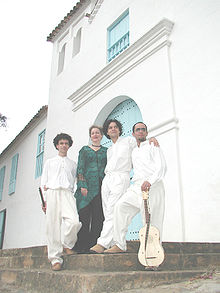- Música Ficta
-
- Disambiguation:
- See musica ficta for the Latin musical term, feigned music.
- There are five early music ensembles with a similar name:
- Musica Ficta (Argentina) founded 1975 by Rubén Soifer.
- Musica Ficta (Colombia) founded in 1988 - the subject of this article.
- Musica Ficta (Spain) founded 1992 by Raúl Mallavibarrena.
- Musica Ficta (Denmark) founded 1996 by Bo Holten.
- Musica Ficta (New Zealand) founded 2007 by Chris Burcin and others.
- The accent on the word música would indicate that the name is to be read as Spanish not Latin. (The adjective ficta is the same in both Latin and Spanish). The Argentinian, Colombian, and Spanish, Música Ficta groups all use the accent on their homepages.
Música Ficta 
Background information Origin Bogota, Colombia Genres Baroque music, Renaissance music Occupations Early music Years active 1988 - present Website www.musicafictaweb.com Members Carlos Serrano, Jairo Serrano, Elisabeth Wright, Julián Navarro Música Ficta is an early music ensemble founded in Bogotá, Colombia, in 1988. The ensemble is specialized in the performance of Latin-American and Spanish renaissance and baroque music. It has performed in over 20 countries in Europe, the USA, Latin America, the Far and Middle East. It has recorded for the labels Jade (France), Arion (France), Centaur (USA) and Arts Music (Germany).
The ensemble has recorded various unedited or scarcely known works from Latin-American musical archives, such as Bogotá, Mexico, Guatemala, Lima and Chiquitos (Bolivia). The group is also known for bringing to light unedited pieces by major 17th century Spanish composers such as Sebastián Durón, Juan de Navas and José Marín.
Current members of the group are: Jairo Serrano (voice, percussion), Carlos Serrano (early woodwinds), Julián Navarro (vihuela de mano, baroque guitar, theorbo) and Elisabeth Wright (harpsichord). The members have taught mainly the Early Music Institute of Indiana University and Pontificia Universidad Javeriana in Bogotá.
Discography
- 1996, p. 2001 - Romances & Villancicos from Spain and the New World. Éditions Jade No. 198-142-2 (France).
- 1999, p. 2000 - De Antequera sale un moro - Music of the Christian, Moorish and Jewish Spain c. 1492. Éditions Jade No. 74321-79256-2 (France).
- 2003, p. 2006 - Sepan todos que muero - Music of Peasants and Courtiers in the Viceroyalty of Peru, 17th-18th Centuries. Centaur Records CRC 2797 (USA).
- 2005, p. 2006 - Esa Noche Yo Bailá - Feast and Devotion in High Peru of the 17th Century. Arts Music No. 47727-8 (Germany).
- 2007, p. 2008 - Del mar del alma - Music and Poetry in Colonial Bogota (17th-18th c.). Arion ARN68789 (France)
External links
Categories:- Colombian musical groups
- Early music groups
- Musical groups established in 1988
- Disambiguation:
Wikimedia Foundation. 2010.
